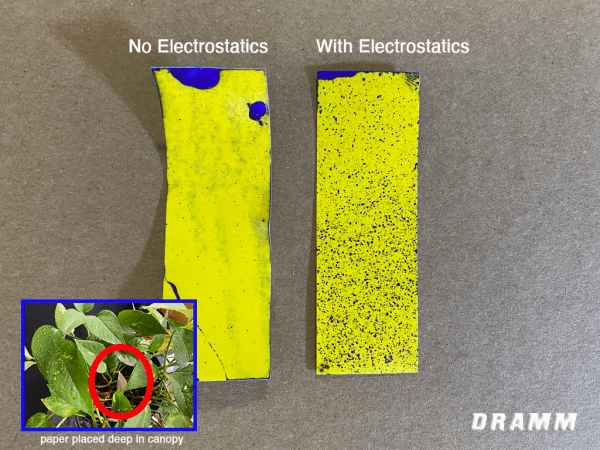Electrostatic spraying has seen an increase in popularity during the pandemic. A wide variety of electrostatic sprayers have been introduced for the application of disinfectants, increasing awareness of the technology.
Electrostatics have their place in horticulture as well. However, a basic understanding of the science can help growers utilize these tools properly.
Electrostatic spraying in agriculture began in the 1950s in England and was developed to reduce spray drift on outdoor agricultural crops. The basics of this technology are simple: spray droplets are passed through a high-voltage field that draws the negative electrons to the surface of the droplet, imparting a negative charge to the droplet as a whole. As a result, these droplets are attracted to grounded surfaces, which will take the opposite charge when confronted with the negatively charged spray droplets.
Another benefit of electrostatic charging is that, because the droplets are all similarly charged, they will repel each other as do magnets with the same polarity. This reduces recombination of droplets as the exit the spray nozzle and causes the spray cloud to be finer.
In the past, electrostatics were not always used properly in greenhouse and horticultural applications. Most electrostatic systems are air atomizing, meaning the droplets are created through the use of an air-shear nozzle that breaks the droplets up with high-pressure or high-volumes of air. In many instances, these machines provide very little force to the spray, reducing the ability of the spray cloud to penetrate plant canopies, especially when dense. Close-target application is important when utilizing electrostatic systems.
Another important factor when using electrostatically charged sprays is that the target will attract more droplets when well grounded. In the greenhouse, this is not always possible as many factors may insulate the crop from ground.
Recently, hydraulic spray nozzles have been adapted to utilize electrostatic spray technology, combining the benefit of a forceful spray with the application of a negative charge to help create finer droplets that will be attracted to grounded surfaces. Still meant as a close-target tool, these hydraulic-electrostatic systems can improve coverage with less run-off and less drift.
Typically utilizing wider fan or conical nozzles, the target distance with these tools is typically no more that 5-6 feet. However, because they utilize higher-pressure hydraulic systems, they can penetrate dense canopies in both vertical and horizontal crops, helping to improve underleaf and inner-canopy spray deposition.
Dramm now offers a three nozzle electrostatic spray wand for application to close horizontal and vertical crops. Coverage of dense crops on 4-5′ wide benches can be improved as the spray can easily penetrate the canopy. This wand, meant to be used with the Dramm Hydra line of hydraulic sprayers, can be used at pressures up to 400 psi for a fine, forceful spray. The wand includes a battery pack generator that provides a low-amperage, high-voltage source for the induction rings in the spray nozzles. With the charge turned on, spray droplets cover interior plant surfaces much more evenly that when the charge is turned off.
The AES Electrostatic Wand is in final development and should be available for general sale in the first quarter of 2022. You may see the AES Wand at various trade shows or on our website.
If you would like to be notified when the AES Electrostatic Wand is available, click here.
Contact any member of the Dramm team for more information.

